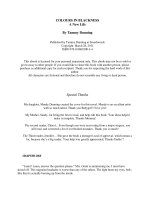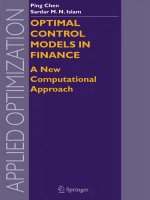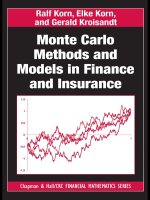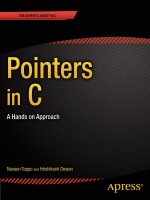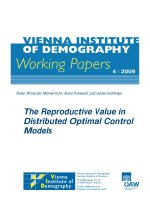optimal control models in finance a new computational approach
Bạn đang xem bản rút gọn của tài liệu. Xem và tải ngay bản đầy đủ của tài liệu tại đây (5.63 MB, 220 trang )
OPTIMAL CONTROL MODELS
IN FINANCE
Applied Optimization
Volume 95
Series Editors:
Panos M. Pardalos
University of Florida, U.S.A.
Donald W. Hearn
University of Florida, U.S.A.
OPTIMAL CONTROL MODELS
IN FINANCE
A New Computational Approach
by
PING CHEN
Victoria University, Melbourne, Australia
SARDAR M.N. ISLAM
Victoria University, Melbourne, Australia
Springer
eBook ISBN: 0-387-23570-1
Print ISBN: 0-387-23569-8
Print ©2005 Springer Science + Business Media, Inc.
All rights reserved
No part of this eBook may be reproduced or transmitted in any form or by any means, electronic,
mechanical, recording, or otherwise, without written consent from the Publisher
Created in the United States of America
Boston
©2005 Springer Science + Business Media, Inc.
Visit Springer's eBookstore at:
and the Springer Global Website Online at:
Contents
List of Figures
List of Tables
Preface
Introduction
ix
xi
xiii
xv
1.
OPTIMAL CONTROL MODELS
1
2
3
4
5
6
7
8
An Optimal Control Model of Finance
(Karush) Kuhn-Tucker Condition
Pontryagin Theorem
Bang-Bang Control
Singular Arc
Indifference Principle
Different Approaches to Optimal Control Problems
Conclusion
1
2
4
6
7
7
8
10
20
2.
THE STV APPROACH TO FINANCIAL OPTIMAL CONTROL
MODELS
1
2
3
4
5
6
7
Introduction
Piecewise-linear Transformation
Non-linear Time Scale Transformation
A Computer Software Package Used in this Study
An Optimal Control Problem When the Control can only Take
the Value 0 or 1
Approaches to Bang-Bang Optimal Control with a Cost of
Changing Control
An Investment Planning Model and Results
21
21
21
23
25
26
27
30
vi
OPTIMAL CONTROL MODELS IN FINANCE
8
Financial Implications and Conclusion
36
3.
A FINANCIAL OSCILLATOR MODEL
1
2
3
4
5
6
7
Introduction
Controlling a Damped Oscillator in a Financial Model
Oscillator Transformation of the Financial Model
Computational Algorithm: The Steps
Financial Control Pattern
Computing the Financial Model: Results and Analysis
Financial Investment Implications and Conclusion
39
39
40
41
44
47
47
89
4.
AN OPTIMAL CORPORATE FINANCING MODEL
1
2
3
4
5
6
7
8
9
Introduction
Problem Description
Analytical Solution
Penalty Terms
Transformations for the Computer Software Package for the
Finance Model
Computational Algorithms for the Non-linear Optimal Control
Problem
Computing Results and Conclusion
Optimal Financing Implications
Conclusion
91
91
91
94
98
99
101
104
107
108
5.
FURTHER COMPUTATIONAL EXPERIMENTS AND RESULTS
1
2
3
4
Introduction
Different Fitting Functions
The Financial Oscillator Model when the Control Takes Three
Values
Conclusion
109
109
109
120
139
6.
CONCLUSION
141
Appendices
145
A CSTVA Program List
145
1
2
3
4
Program A: Investment Model in Chapter 2
Program B: Financial Oscillator Model in Chapter 3
Program C: Optimal Financing Model in Chapter 4
Program D: Three Value-Control Model in Chapter 5
145
149
153
156
Contents
vii
B
Some Computation Results
1
2
3
4
Results for Program A
Results for Program B
Results for Program C
Results for Program D
C
D
E
F
Differential Equation Solver from the SCOM Package
SCOM Package
Format of Problem Optimization
A Sample Test Problem
161
161
163
167
175
181
183
189
191
References
Index
193
199
This page intentionally left blank
List of Figures
2.1
2.2
2.3
2.4
2.5
2.6
Plot of n=2, forcing function ut=1,0
Plot of n=4, forcing function ut=1,0,1,0
Plot of n=6, forcing function ut= 1,0,1,0,1,0
Plot of n=8, forcing function ut= 1,0,1,0,1,0,1,0
Plot of n=10, forcing function ut= 1,0,1,0,1,0,1,0,1,0
Plot of the values of the objective function to the num-
ber of the switching times
2.7
3.1
3.2
3.3
Plot of the cost function to the cost of switching control
Plot of integral F against 1/ns at ut=-2,2
Plot of integral F against 1/ns at ut=2,-2
Plot of cost function F against the number of large time
intervals nb
5.1
5.2
5.3
5.4
5.5
5.6
5.7
5.8
Plot of n=4, forcing function ut=1,0,1,0
Plot of n=10, forcing function ut= 1,0,1,0,1,0,1,0,1,0
Results of objective function at n=2,4,6,8,10
Plot of n=4, forcing function ut=1,0,1,0
Plot of n=8, forcing function ut=1,0,1,0,1,0,1,0
Plot of n=8, forcing function ut= 1,0,1,0,1,0,1,0
Plot of nb=9, ns=8, forcing function ut=-2,0,2,-2,0,2,-2,0,2
Relationship between two state functions during the
time period 1,0
31
31
32
32
33
34
35
87
87
88
110
112
113
116
117
119
123
123
This page intentionally left blank
List of Tables
2.1
2.2
3.1
3.2
4.1
4.2
4.3
5.1
5.2
5.3
5.4
Objective functions with the number of the switching times
Costs of the switching control attached to the objective
function
Results of the objective function at control pattern -2,2, . . .
Results of the objective function at control pattern 2,-2, .
Computing results for solution case [1]
Computing results for solution case [2]
Computing results for solution case 2 with another map-
ping control
Results of objective function at n=2,4,6,8,10
Results of objective functions at n=2,6,10
Test results of the five methods
Results of financial oscillator model
33
34
48
86
105
106
106
114
118
120
121
This page intentionally left blank
Preface
This book reports initial efforts in providing some useful extensions in fi-
nancial modeling; further work is necessary to complete the research agenda.
The demonstrated extensions in this book in the computation and modeling
of optimal control in finance have shown the need and potential for further
areas of study in financial modeling. Potentials are in both the mathematical
structure and computational aspects of dynamic optimization. There are needs
for more organized and coordinated computational approaches. These exten-
sions will make dynamic financial optimization models relatively more stable
for applications to academic and practical exercises in the areas of financial
optimization, forecasting, planning and optimal social choice.
This book will be useful to graduate students and academics in finance,
mathematical economics, operations research and computer science. Profes-
sional practitioners in the above areas will find the book interesting and infor-
mative.
The authors thank Professor B.D. Craven for providing extensive guidance
and assistance in undertaking this research. This work owes significantly to
him, which will be evident throughout the whole book. The differential equa-
tion solver “nqq” used in this book was first developed by Professor Craven.
Editorial assistance provided by Matthew Clarke, Margarita Kumnick and Tom
Lun is also highly appreciated. Ping Chen also wants to thank her parents for
their constant support and love during the past four years.
PING CHEN AND SARDAR M.N. ISLAM
This page intentionally left blank
Introduction
Optimal control methods have significant applications in finance. This book
discusses the general applications of optimal control methods to several areas
in finance with a particular focus on the application of bang-bang control to
financial modeling.
During the past half-century, many optimization problems have arisen in
fields such as finance management, engineering, computer science, production,
industry, and economics. Often one needs to optimize (minimize or maximize)
certain objectives subject to some constraints. For example, a public utility
company must decide what proportion of its earnings to retain to the advantage
of its future earnings at the expense of gaining present dividends, and also
decide what new stock issues should be made. The objective of the utility is
to maximize the present value of share ownership, however, the retention of
retained earnings reduces current dividends and new stock issues can dilute
owners’ equity.
Some optimization problems involve optimal control, which are consider-
ably more complex and involve a dynamic system. There are very few real-
world optimal control problems that lend themselves to analytical solutions.
As a result, using numerical algorithms to solve the optimal control problems
becomes a common approach that has attracted attention of many researchers,
engineers and managers. There are many computational methods and theoreti-
cal results that can be used to solve very complex optimal control problems. So
computer software packages of certain optimal control problems are becoming
more and more popular in the era of a rapidly developing computer industry.
They rescue scientists from large calculations by hand.
Many real-world financial problems are too complex for analytical solu-
tions, so must be computed. This book studies a class of optimal financial
control problems where the control takes only two (or three) different discrete
values. The non-singular optimal control solution of linear-analytic systems in
finance with bounded control is commonly known as the bang-bang control.
The problem of finding the optimal control becomes one of finding the switch-
xvi
OPTIMAL CONTROL MODELS IN FINANCE
ing times in the dynamic financial system. A cost of switching control is added
to usual models since there is a cost for switching from one financial instrument
to another. Computational algorithms based on the time scaled transformation
technique are developed for this kind of problems. A set of computer software
packages named CSTVA is generated for real-world financial decision-making
models.
The focus in this research is the development of computational algorithms
to solve a class of non-linear optimal control problems in finance (bang-bang
control) that arise in operations research. The Pontryagin theory [69, 1962] of
optimal control requires modification when a positive cost is associated with
each switching of the control. The modified theory, which was first introduced
by Blatt [2, 1976], will give the solutions of a large class of optimal control
problems that cannot be solved by standard optimal control theories. The the-
orem is introduced but not used to solve the problems in this book. However,
the cost of changing control, which is attached to the cost function, is used
here for reaching the optimal solution in control system. In optimization com-
putation, especially when calculating minimization of an integral, an improved
result can be obtained by using a greater number of time intervals.
In this research, a modified version of the Pontryagin Principle, in which
a positive cost is attached to each switching of the control, indicates that a
form of bang-bang control is optimal. Several computational algorithms were
developed for such financial control problems, where it is essential to com-
pute the switching times. In order to achieve the possibility of computation,
some transformations are included to convert control functions, state functions
and the integrals from their original mathematical forms to computable forms.
Mainly, the MATLAB “constr” optimization package was applied to construct
the general computer programs for different classes of optimal control prob-
lems. A simplified financial optimal control problem that only has one state
and one control is introduced first. The optimal control of such a problem
is bang-bang control, which switches between two values in successive time
intervals. A computer software package was developed for solving this partic-
ular problem, and accurate results were obtained. Also some transformations
are applied into the problem formalization. A financial oscillator problem is
then treated, which has two states and one control. The transformation of sub-
division of time interval technique is used to gain a more accurate gradient.
Different sequences of control are then studied. The computational algorithms
are applied to a non-linear optimal control problem of an optimal financing
model, which was original introduced by Davis and Elzinga [22, 1970]. In that
paper, Davis and Elzinga had an analytical solution for the model. In this book
a computer software package was developed for the same model, including set-
ting up all the parameters, calculating the results, and testing different initial
points of an iterative algorithm. During the examination of the algorithms, it
INTRODUCTION
xvii
was found that sometimes a local minimum was reached instead of a global
optimum. The reasons for the algorithms leading to such a local minimum are
indicated, and as a result, a part of the algorithms are modified so as to obtain
the global optimum eventually.
The computing results were obtained, and are presented in graphical forms
for future analysis and improvement here. This work is also compared with
other contemporary research. The advantages and disadvantages of them are
analyzed. The STV approach provides an improved computational approach
by combing the time discretization method, the control step function method,
the time variable method, the consideration of transaction costs and by coding
the computational requirements in a widely used programming system MAT-
LAB. The computational experiments validated the STV approach in terms of
computational efficiency, and time, and the plausibility of results for financial
analysis.
The present book also provides a unique example of the feasibility of model-
ing and computation of the financial system based on bang-bang control meth-
ods. The computed results provide useful information about the dynamics of
the financial system, the impact of switching times, the role of transaction
costs, and the strategy for achieving a global optimum in a financial system.
One of the areas of applications of optimal control models is normative so-
cial choice for optimal financial decision making. The optimal control models
in this book have this application as well. These models specify the welfare
maximizing financial resource allocation in the economy subject to the under-
lying dynamic financial system.
Chapter 1 is an introduction to the optimal control problems in finance and
the classical optimal control theories, which have been successfully used for
years. Some relevant sources in this research field are also introduced and
discussed.
Chapter 2 discusses a particular case of optimal control problems and the
switching time variable (STV) algorithm. Some useful transformations intro-
duced in Section 2.2 are standard for the control problems. The piecewise-
linear transformation and the computational algorithms discussed in Section
2.6 are the main work in this book. A simple optimal aggregate investment
planning model is presented here. Accurate results were obtained in using
these computational algorithms, and are presented in Section 2.7. A part of
the computer software SCOM developed in Craven and Islam [18, 2001] and
Islam and Craven [38, 2002] is used here to solve the differential equation.
Chapter 3 presents a financial oscillator model (which is a different version
of the optimal aggregative investment planning model developed in Chapter 2)
whose state is a second-order differential equation. A new time-scaled trans-
formation is introduced in Section 3.3. The new transformation modifies the
old transformations that are used in Chapter 2. All the modifications are made
xviii
OPTIMAL CONTROL MODELS IN FINANCE
to match the new time-scale division. The computational algorithms for this
problem and the computing results are also discussed. An extension of the con-
trol pattern is indicated. The new transformation and algorithms in this chapter
are the important parts in this research.
Chapter 4 contains an optimal financing model, which was first introduced
by Davis and Elzinger [22, 1970]. A computer software package for this
model is constructed in this book (for details see Appendix A.3 model 1_1.m -
model1_5.m). The computing result is compared with the analytical result and
another computing result obtained from using the SCOM package.
Chapter 5 reports computing results of the algorithms 2.1-2.3 and algorithms
3.1-3.4 in other cases of optimal control problems. After analyzing the results,
the computer packages in Appendix A.1 and Appendix A.2 (project1_1.m -
project1_4.m and project2_2.m - project2_4.m) have been improved.
Chapter 6 gives the conclusion of this research. Optimal control methods
have high potential applications to various areas in finance. The present study
has enhanced the state of the art for applying optimal control methods, es-
pecially the bang-bang control method, for financial modeling in a real life
context.
Chapter 1
OPTIMAL CONTROL MODELS IN FINANCE
Optimal control theory has been important in finance (Islam and Craven [38,
2002]; Taperio [81, 1998]; Ziemba and Vickson [89, 1975]; Senqupta and Fan-
chon [80, 1997]; Sethi and Thompson [79, 2000]; Campbell, Lo and MacKin-
lay [7, 1997]; Eatwell, Milgate and Neuman [25, 1989]). During nearly fifty
years of development and extension of optimal control theories, they have been
successfully used in finance. Many famous models effectively utilize optimal
control theories. However, with the increasing requirements of more workable
and accurate solutions to optimal control problems, there are many real-world
problems which are too complex to lead to analytical solutions. Computational
algorithms therefore become essential tools for most optimal control problems
including dynamic optimization models in finance.
Optimal control modeling, both deterministic and stochastic, is probably
one of the most crucial areas in finance given the time series characteristics
of financial systems’ behavior. It is also a fast growing area of sophisticated
academic interest as well as practice using analytical as well as computational
techniques. However, there are some limits in some areas in the existing lit-
erature in which improvements are needed. It will facilitate the discipline if
dynamic optimization in finance is to be at the same level of development
in modeling as the modeling of optimal economic growth (Islam [36, 2001];
Chakravarty [9, 1969]; Leonard and Long [52, 1992]). These areas are: (a)
specification of the element of the dynamic optimization models; (b) the struc-
ture of the dynamic financial system; (c) mathematical structure; and (d) com-
putational methods and programs. While Islam and Craven [38, 2002] have
recently made some extensions to these areas, their work does not explicitly
focus on bang-bang control models in finance. The objective of this book is
to present some suggested improvements in modeling bang-bang control in
2
OPTIMAL CONTROL MODELS IN FINANCE
finance in the deterministic optimization strand by extending the existing liter-
ature.
In this chapter, a typical general financial optimal control model is given in
Section 1.1 to explain the formula of the optimal control problems and their
accompanying optimal control theories. In addition, some classical concepts
in operations research and famous standard optimal control theories are intro-
duced in Section 1.2-1.5, and a brief description on how they are applied in
financial optimal control problems is also discussed. In Section 1.6, some im-
provements that are needed to meet the higher requirements for the complex
real-world problems are presented. In Section 1.7, the algorithms on similar
optimal control problems achieved by other researchers are discussed. Critical
comparisons of the methods used in this research and those employed in oth-
ers’ work are made, and the advantages and disadvantages between them are
shown to motivate the present research work.
1.
An Optimal Control Model of Finance
Consider a financial optimal control model:
subject to:
Here is the state, and is the control. The time T is the “planning
horizon”. The differential equation describes the dynamics of the
financial system; it determines from It is required to find an optimal
which minimizes (We may consider as a cost function.) Al-
though the control problem is stated here (and other chapters in this book) as a
minimization problem, many financial optimization models are in a maximiza-
tion form. Detailed discussion of control theory applications to finance may be
seen in Sethi and Thompson [79, 2000].
Often, is taken as a piece-wise continuous function (note that jumps
are always needed if the problem is linear in the control to reach an op-
timum), and then is a piece-wise smooth function. A financial optimal
control model is represented by the formula (1.1)-(1.4), and can always use
the “maximum principle” in Pontryagin theory [69, 1962]. The cost function
is usually the sum of the integral cost and terminal cost in a standard optimal
Optimal Control Models
3
control problem which can be found in references [1, 1988], [5, 1975], and
[8, 1983]. However, for a large class of reasonable cases, there are often no
available results from standard theories. A more acceptable method is needed.
In Blatt [2, 1976], there is some cost added when switching the control. The
cost can be wear and tear on the switching mechanism, or it can be as the cost
of “loss of confidence in a stop-go national economy”. The cost is associated
with each switching of control. The optimal control problem in financial deci-
sion making with a cost of switching control can be described as follows:
subject to:
Here, is the positive cost. is an integer, representing the number of
times the control jumps during the planning period [0, T]. In particular,
may be a piece-wise constant, thus it can be approximated by a step-function.
Only fixed-time optimal control problems are considered in this book which
means T is a constant. Although time-optimal control problems are also very
interesting, they have not been considered in this research.
The essential elements of an optimal control model (see Islam [36, 2001])
are: (i) an optimization criteria; (ii) the form of inter-temporal time preference
or discounting; (iii) the structure of dynamic systems-under modeling; and(iv)
the initial and terminal conditions. Although the literature on the method-
ologies and practices in the specification of the elements of an optimal con-
trol model is well developed in various areas in economics (such as optimal
growth, see Islam [36, 2001]; Chakravarty [9, 1969]), the literature in finance
in this area is not fully developed (see dynamic optimization modeling in Ta-
perio [81, 1998]; Sengupta and Fanchon [80, 1997]; Zieamba and Vickson
[89, 1975]). The rationale for and requirements of the specification of the
above four elements of dynamic optimization financial models are not pro-
vided in the existing literature except in Islam and Craven [38, 2002]. In the
present study, the main stream practices are adopted: (i) an optimization crite-
ria (of different types in different models); (ii) the form of inter-temporal time
preference-positive or zero discounting; (iii) the structure of dynamic systems
4
OPTIMAL CONTROL MODELS IN FINANCE
under modeling (different types – linear and non-linear); and (iv) the initial
and terminal conditions – various types in different models.
Optimal control models in finance can take different forms including the
following: bang-bang control, deterministic and stochastic models, finite and
infinite horizon models, aggregative and disaggregative, closed and open loop
models, overtaking or multi-criteria models, time optimal models, overlapping
generation models, etc.(see Islam [36, 2001]).
Islam and Craven [38, 2002] have proposed some extensions to the method-
ology of dynamic optimization in finance. The proposed extensions in the
computation and modeling of optimal control in finance have shown the need
and potential for further areas of study in financial modeling. Potentials are
in both mathematical structure and computational aspects of dynamic opti-
mization. These extensions will make dynamic financial optimization models
relatively more organized and coordinated. These extensions have potential ap-
plications for academic and practical exercises. This book reports initial efforts
in providing some useful extensions; further work is necessary to complete the
research agenda.
Optimal control models have applications to a wide range of different areas
in finance: optimal portfolio choice, optimal corporate finance, financial engi-
neering, stochastic finance, valuation, optimal consumption and investment,
financial planning, risk management, cash management, etc. (Tapiero [81,
1998]; Sengupta and Fanchon [80, 1997]; Ziemba and Vickson [89, 1975]).
As it is difficult to cover all these applications in one volume, two important
areas in financial applications of optimal control models – optimal investment
planning for the economy and optimal corporate financing – are considered in
this book.
2.
(Karush) Kuhn-Tucker Condition
The Kuhn-Tucker Condition condition is the necessary condition for a local
minimum of a minimization problem (see [14, 1995]). The Hamiltonian of
the Pontryagin maximum principle is based on a similar idea that deals with
optimal control problems.
Consider a general mathematical programming problem:
subject to:
Optimal Control Models
5
The Lagrangian is:
The (Karush-) Kuhn-Tucker conditions necessary for a (local) minimum
of the problem at are that Lagrange multipliers and exist, for
which satisfies the constraints of the problem, and:
The inequality constraints are written here as then the corresponding
at the minimum; the multipliers of the equality constraints can take any
sign. So for some minimization problems where the inequality constraints are
represented as the sign of the inequalities should be changed first. Then
the KKT condition can be applied.
The conditions for global minimum are that the objective and constraint
functions are differentiable, and satisfy the constraint qualifications and are
convex and concave respectively. If these functions are strictly convex then the
minimum is also a unique minimum. Further extensions to these conditions
have been made in the cases when the objective and constraint functions are
quasi-convex and invex (see Islam and Craven [37, 2001]).
Duality properties of the programming models in finance not only provide
useful information for computing purposes, but also for determining efficiency
or show prices of financial instruments.
6
OPTIMAL CONTROL MODELS IN FINANCE
3.
Pontryagin Theorem
The Pontryagin theorem was first introduced in Pontryagin [69, 1962].
Consider a minimization problem in finance given as follows:
T is planning horizon, subject to a differential equation and some constraint:
Here (1.23) represents the differential equation. (1.24) represents the con-
straint on control
Let the optimal control problem (1.22) reach a (local) minimum at
with respect to the for Assume that and are partially Fr
é
chet
differentiable with respect to uniformly in near The Hamiltonian is
shown as follows:
The necessary conditions for the minimum are:
(a) a co-state function satisfies the adjoint differential equation:
with boundary condition.
(b) the associated problems minimize at for all except at a null set.
